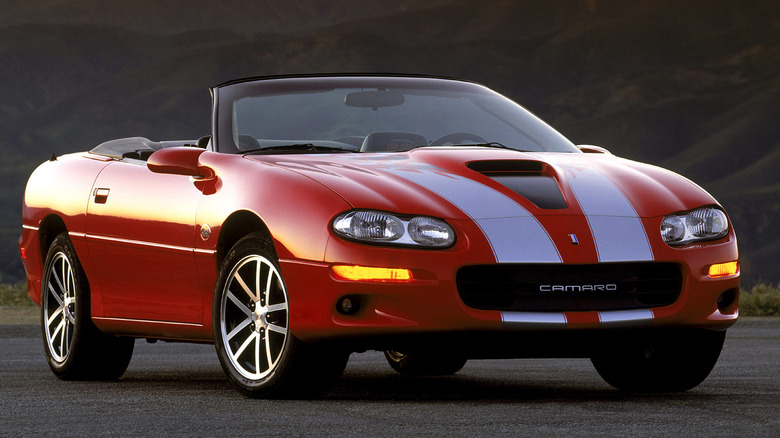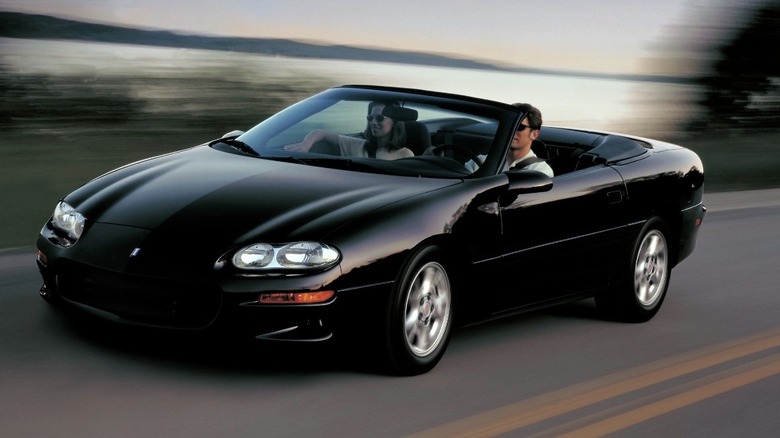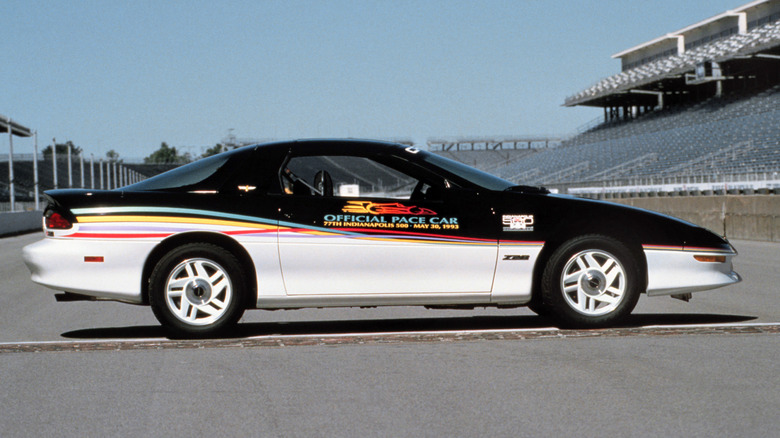Everything You Should Know About The 4th Gen 'Catfish' Camaro
In the late-1980s, GM briefly considered discontinuing its iconic Camaro and Firebird — pony cars as we know them — in favor of moving the automaker's entire product line toward smaller, front-wheel drive platforms. But after witnessing Ford's debacle of trying to replace its Mustang with the Probe, GM decided to stay the course with a V8-powered rear-wheel drive muscle machine. And so died the ill-fated GM80 platform, intended for the fourth-generation pony cars. Instead, the new Camaro would ride on a heavily revised version of the third-gen's F-body chassis.
Unlike the outgoing car, the fourth-gen Camaro was simplified with only two engine choices, one V6 and one V8. If you're reading this article, you're probably interested in the performance-oriented V8 version, dubbed the Z28, so we'll focus on that. The new-for-1993 Z28 featured Chevy's equally new 5.7-liter LT1 which debuted in the Corvette just one year earlier. In the Camaro, it was slightly detuned to make 275 horsepower. After all, you can't have the Camaro making the same or more horsepower than GM's halo car, the Corvette. Z28 buyers could choose between a four-speed automatic transmission or a new six-speed manual transmission at no extra cost.
The 275 horsepower LT1 put the Camaro light years ahead of competitors like Ford's Mustang, which had a 4.6-liter V8 that made only 215 horsepower. In a Car and Driver comparison test of the 1994 Camaro Z28 versus a 1994 Mustang GT, the Z28 sent the Mustang GT to the glue factory with a zero to 60 time of 5.4 seconds versus 6.1 for the Mustang. A measurement of top speed had similar results with the Z28 reaching 156 mph while the GT could only muster 137 mph.
1998 introduced the true catfish
The fourth-generation Camaro's looks were always somewhat polarizing. For the first time ever, GM used sheet molded compound (SMC) panels for the Camaro's fenders, doors, roof, and rear hatch. Similar to fiberglass, the molded SMC panels saved weight and gave the 1993 Camaro its unique rounded shape, which some enthusiasts criticized as bulbous and plasticky versus the clean, angular lines of the third-gen cars.
But nothing would prepare fans for 1998's mid-cycle refresh, which introduced a hideous new front clip that earned it the nickname "catfish" Camaro. And looking at photos, it's easy to see why — the oversize radiator grill and rounded flush headlamps really do resemble the bottom-feeding lake dweller. To be fair, many cars of this era are guilty of shapeless styling that looks as if were left in the sun too long and melted. But what the 1998 refresh lacked in looks, it made up in horsepower. A new LS1 aluminum V8 was brought onboard that churned out 305 horsepower, reducing its zero to 60 mph time to 5.2 seconds.
It's finally getting appreciated
Another reason to like the "Catfish" Camaros is the return of the long-defunct Super Sport (SS) moniker to the Camaro. Depending on the year, the SS package was either an option package for the Z28 or its own distinct trim level. In either case, the SS was a collaboration between GM and Street Legal Performance (SLP) in Michigan. The SLP touch typically consisted of increased performance via engine modifications, suspension tuning, larger wheels, and appearance parts like a scooped hood.
The fourth-generation Camaro soldiered on until it was discontinued in 2002 due to a drop in demand for sports cars. However, these once under-appreciated muscle cars are experiencing a surge of interest lately. And why not? They're incredibly quick — even by modern standards — and perhaps enthusiasts are mellowing on their disdain for the radical styling. If you're interested in picking one up, Classic.com reports a 12-month average price of $17,337 for the Z28 and $25,077 for the rarer SS. Of course, mint examples with low mileage will command bigger bucks.


